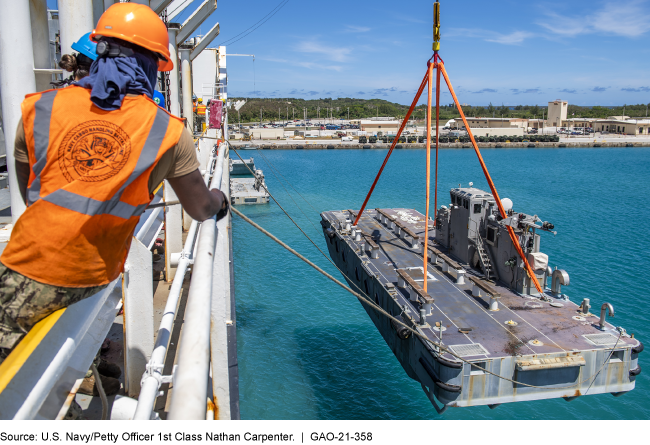Warfighter Support: DOD Needs a Complete Picture of the Military Services' Prepositioning Programs
Fast Facts
The U.S. military services preposition their assets—including combat vehicles, rations, medical supplies, and repair parts—on land and on the water at strategic locations around the world. The Department of Defense uses these assets for combat, to support allies, and for disaster and humanitarian assistance.
DOD does not have a complete picture of the services' prepositioning programs. Improved joint oversight would allow DOD to better identify shortfalls, redundancies, and more.
Our recommendation addresses this issue.

Highlights
What GAO Found
The services preposition combat and support assets ashore and afloat worldwide, including in the Indo-Pacific region. Prepositioned assets include combat vehicles, equipment sets for engineering and construction, and protective gear for chemical or biological attacks. During the COVID-19 pandemic, the Department of Defense (DOD) used prepositioned medical assets for personnel in Guam, South Korea, and Germany. All of the services have reported some shortfalls in their prepositioned assets from 2015 through 2019—including mortars, combat vehicles, and medical equipment. In the Indo-Pacific region, for example, the Army reported shortfalls in equipment to construct bridges over difficult terrain. All services also cited challenges, such as insufficient storage space, storage facilities located far away from intended points of use, and the perishability of some assets. In some cases, the services are taking actions to address these shortfalls and challenges. In others, the services are accepting risk because, according to officials, not all shortfalls and challenges can be fully addressed.
Sailors and Marines Offload Assets from a Prepositioning Ship during the COVID-19 Response in Guam

DOD has taken steps to implement a joint oversight framework but does not have a complete view of the services' prepositioning programs. DOD revised two guidance documents—an instruction in 2019 and a strategic implementation plan in 2020—to establish a joint oversight framework. However, DOD has focused much of its joint efforts to date on preparing a required annual report to Congress on the status of the services' prepositioning programs. While the report provides some useful information, GAO found inaccurate and inconsistent information in multiple annual reports, which hinder their utility. DOD does not have a reporting mechanism or information-collection tool to develop a complete picture of the services' prepositioning programs. The current annual reporting requirement expires in 2021, which provides DOD with an opportunity to create a new reporting mechanism, or modify existing mechanisms or tools, to enable a complete picture of the services' prepositioning programs. By doing so, DOD could better identify gaps or redundancies in the services' programs, make more informed decisions to mitigate asset shortfalls and challenges, reduce potential duplication and fragmentation, and improve its joint oversight.
Why GAO Did This Study
The U.S. military services preposition critical assets at strategic locations around the world for access during the initial phases of an operation. DOD uses these prepositioned assets for combat, support to allies, and disaster and humanitarian assistance. For many years, GAO has identified weaknesses in DOD's efforts to establish a joint oversight framework to guide its ability to assess the services' prepositioning programs. This has led to fragmentation and the potential for duplication.
Senate Report 116-48 included a provision for GAO to evaluate the services' prepositioning programs and associated challenges. This report (1) describes the types of assets the services preposition worldwide, as well as asset shortfalls and challenges the services have identified, and (2) assesses the extent to which DOD has made progress in implementing a joint oversight framework for the services' programs. To conduct this work, GAO reviewed DOD prepositioning documents and interviewed DOD and State Department officials from over 20 offices.
This is a public version of a sensitive report that GAO issued in December 2020. Information that DOD deemed sensitive has been omitted.
Recommendations
GAO recommends that DOD develop a reporting mechanism or tool to gather complete information about the military services' prepositioning programs for joint oversight and to reduce duplication and fragmentation. DOD concurred with the recommendation.
Recommendations for Executive Action
| Agency Affected | Recommendation | Status |
|---|---|---|
| Department of Defense | The Secretary of Defense should ensure that the Assistant Secretary of Defense for Sustainment, in coordination with the Chairman of the Joint Chiefs of Staff, develop and implement a new reporting mechanism or information-collection tool, or modify existing mechanisms or tools, to gather complete information about the military services' prepositioning programs for joint oversight purposes and to reduce potential duplication and fragmentation. (Recommendation 1) |
DOD agreed with GAO's March 2021 recommendation and has implemented it. As of December 2021, DOD officials stated that they had completed a review of the information systems and data related to the military services' prepositioning programs. In December 2021, DOD officials (1) completed a review of the information systems and data related to the military services' prepositioning programs and (2) decided to update the classified Defense Readiness Reporting System to provide a single view capability of information about the services' prepositioned programs. In 2022, DOD completed this single view web-based analytic capability to enable comprehensive prepositioning data collection and related reporting mechanism. In February 2023, DOD provided classified joint oversight reports containing various prepositioning data outputs from the single view capability. These actions meet the recommendation's intent and may help the department better identify gaps or redundancies in the services' prepositioned programs, make more informed decisions to mitigate asset shortfalls and challenges, reduce potential duplication and fragmentation, and improve its joint oversight.
|
